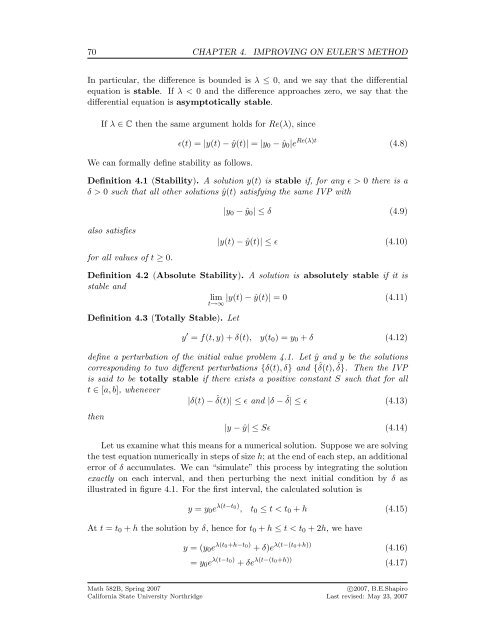The Computable Differential Equation Lecture ... - Bruce E. Shapiro
The Computable Differential Equation Lecture ... - Bruce E. Shapiro
The Computable Differential Equation Lecture ... - Bruce E. Shapiro
You also want an ePaper? Increase the reach of your titles
YUMPU automatically turns print PDFs into web optimized ePapers that Google loves.
70 CHAPTER 4. IMPROVING ON EULER’S METHOD<br />
In particular, the difference is bounded is λ ≤ 0, and we say that the differential<br />
equation is stable. If λ < 0 and the difference approaches zero, we say that the<br />
differential equation is asymptotically stable.<br />
If λ ∈ C then the same argument holds for Re(λ), since<br />
We can formally define stability as follows.<br />
ɛ(t) = |y(t) − ŷ(t)| = |y 0 − ŷ 0 |e Re(λ)t (4.8)<br />
Definition 4.1 (Stability). A solution y(t) is stable if, for any ɛ > 0 there is a<br />
δ > 0 such that all other solutions ŷ(t) satisfying the same IVP with<br />
|y 0 − ŷ 0 | ≤ δ (4.9)<br />
also satisfies<br />
for all values of t ≥ 0.<br />
|y(t) − ŷ(t)| ≤ ɛ (4.10)<br />
Definition 4.2 (Absolute Stability). A solution is absolutely stable if it is<br />
stable and<br />
lim |y(t) − ŷ(t)| = 0 (4.11)<br />
t→∞<br />
Definition 4.3 (Totally Stable). Let<br />
y ′ = f(t, y) + δ(t), y(t 0 ) = y 0 + δ (4.12)<br />
define a perturbation of the initial value problem 4.1. Let ŷ and y be the solutions<br />
corresponding to two different perturbations {δ(t), δ} and {ˆδ(t), ˆδ}. <strong>The</strong>n the IVP<br />
is said to be totally stable if there exists a positive constant S such that for all<br />
t ∈ [a, b], whenever<br />
|δ(t) − ˆδ(t)| ≤ ɛ and |δ − ˆδ| ≤ ɛ (4.13)<br />
then<br />
|y − ŷ| ≤ Sɛ (4.14)<br />
Let us examine what this means for a numerical solution. Suppose we are solving<br />
the test equation numerically in steps of size h; at the end of each step, an additional<br />
error of δ accumulates. We can “simulate” this process by integrating the solution<br />
exactly on each interval, and then perturbing the next initial condition by δ as<br />
illustrated in figure 4.1. For the first interval, the calculated solution is<br />
y = y 0 e λ(t−t 0) , t 0 ≤ t < t 0 + h (4.15)<br />
At t = t 0 + h the solution by δ, hence for t 0 + h ≤ t < t 0 + 2h, we have<br />
y = (y 0 e λ(t 0+h−t 0 ) + δ)e λ(t−(t 0+h))<br />
= y 0 e λ(t−t 0) + δe λ(t−(t 0+h))<br />
(4.16)<br />
(4.17)<br />
Math 582B, Spring 2007<br />
California State University Northridge<br />
c○2007, B.E.<strong>Shapiro</strong><br />
Last revised: May 23, 2007
















